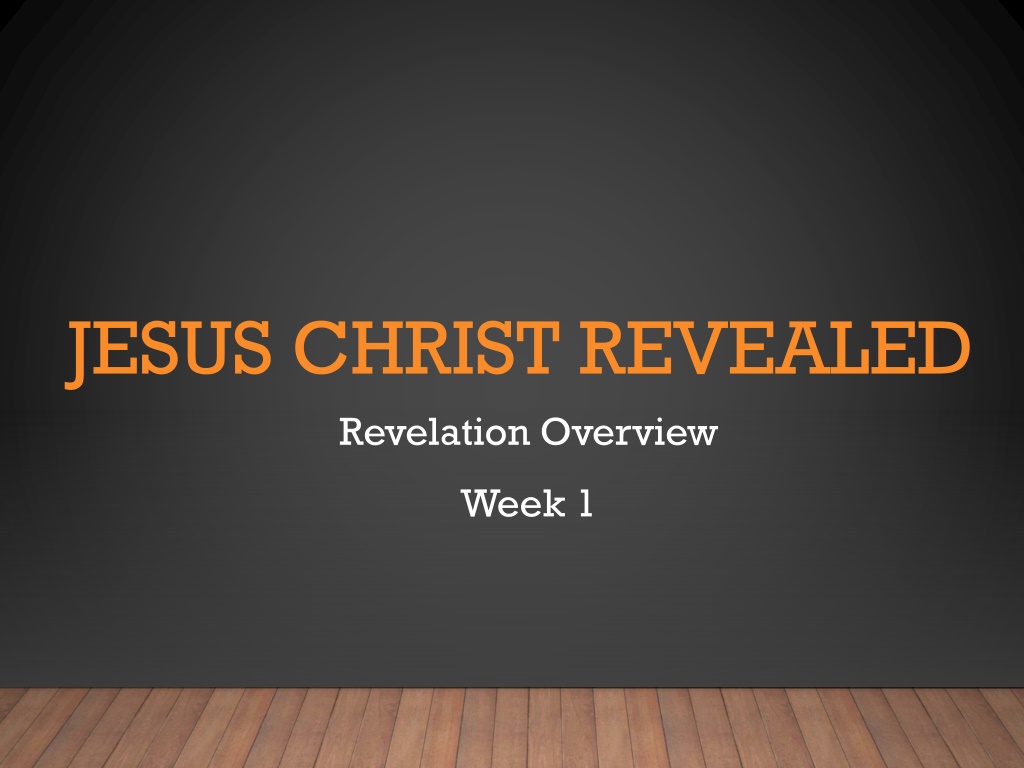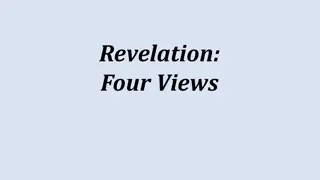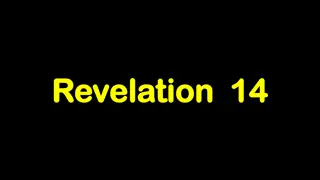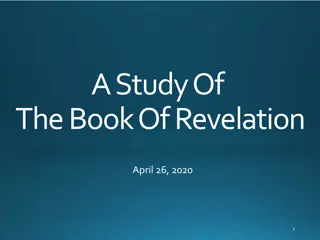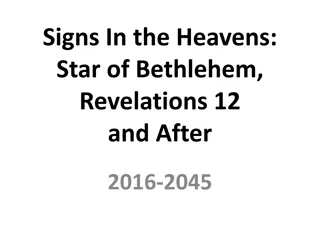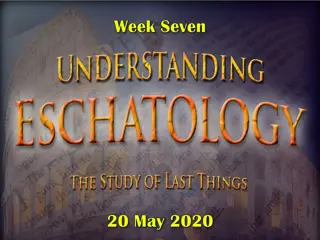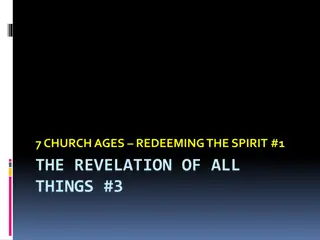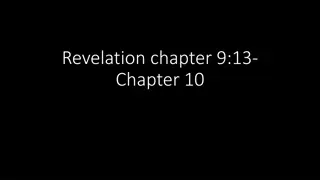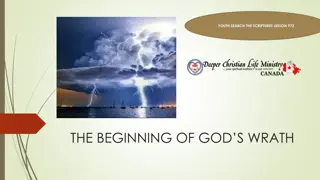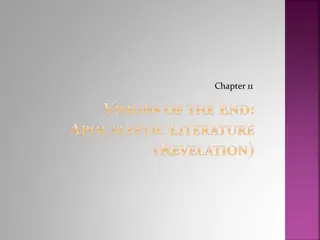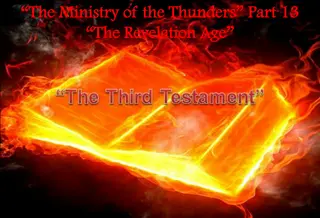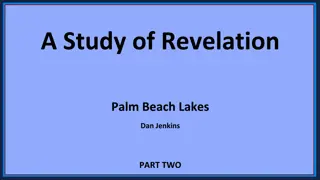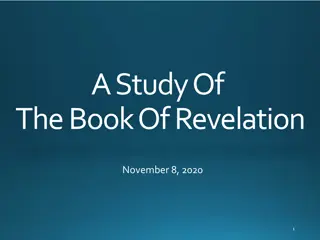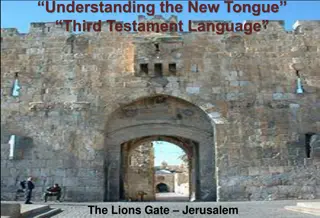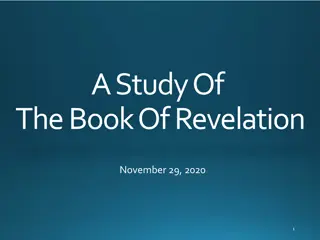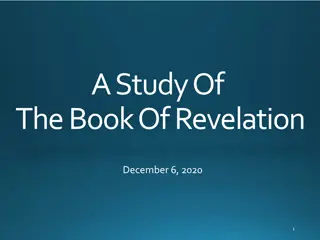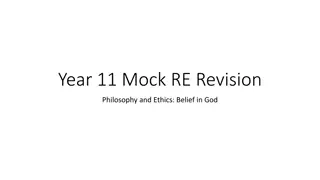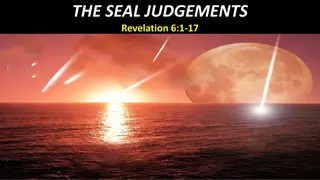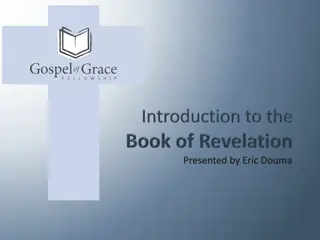Understanding the Book of Revelation: Insights and Perspectives
The Book of Revelation offers a profound unveiling of Jesus Christ's message, with different views interpreting its symbols and timelines. It explores spiritual truths, historical events, church eras, and future prophecies, igniting discussions on Israel, Rome, tribulations, and the Second Coming.
Download Presentation

Please find below an Image/Link to download the presentation.
The content on the website is provided AS IS for your information and personal use only. It may not be sold, licensed, or shared on other websites without obtaining consent from the author. Download presentation by click this link. If you encounter any issues during the download, it is possible that the publisher has removed the file from their server.
E N D
Presentation Transcript
JESUS CHRIST REVEALED Revelation Overview Week 1
REVELATION 1:1-3, 19 The revelation [ apocalypse or unveiling ] of Jesus Christ, which God gave him to show to his servants the things that must soon take place. He made it known by sending his angel to his servant John, who bore witness to the word of God and to the testimony of Jesus Christ, even to all that he saw. Blessed is the one who reads aloud the words of this prophecy, and blessed are those who hear, and who keep what is written in it, for the time is near. . . Write therefore the things that you have seen, those that are and those that are to take place after this. (ESV)
FOUR VIEWS OF REVELATION Symbolist/Idealist/Spiritualist View Spiritual truths that apply to the church in all ages. Preterist View Literal, historical events that took place in the first century. Either the Fall of Jerusalem or Rome is in view. Historicist: Outlines the major eras in church history, in the seven letters and then in the rest of the book. Futurist: Revelation describes events in the future, near the end of the world (most commonly during the Great Tribulation, a seven-year period leading up to the Second Coming of Christ).
PRETERISM Two versions: Fall of Jerusalem in AD 70 Fall of Rome, the Persecutor of Christians Problems: Unbelieving Israel is judged, but is not the focus of God s judgment the wicked nations are. (Dan. 2 & 7) View 1 requires an early date for Revelation, before AD 70 BOTH views are problematic because Revelation seems so clearly to be leading up to and describing FINAL judgment, not some lesser event, whether the Fall of Jerusalem or Rome.
HISTORICISM Sees the Seven Letter, Seven Seals, Seven Bowls, Seven Trumpets, Etc. as Seven Periods in Church History Identifies passages in Revelation as corresponding to specific events in Church History invasions of Goths, Muslims, corruption of Medieval Papacy, etc. Problems: Too specific. Always used to prove that Jesus must be coming again very soon (trying to predict the date of the Second Coming) Makes the letter less relevant to its original audience.
FUTURISM Everything from Ch. 4 on refers to things that have not yet happened future events immediately preceding and including the Second Coming. Most Popular: Dispensational Futurism Events: restoration of ethnic Israel, rapture, 7-year tribulation, reign of antichrist, assembly of evil nations to fight Israel, Christ s Second Coming, the millennial reign of Christ, Satan s final rebellion at the end of the millennium, Christ s final defeat of Satan & His eternal reign. Second View: Modified Futurism not as literal or precise, no pre-tribulation rapture. Some: Ch. 4-7, time between Resurrection & the Tribulation Problem: Book has little/no significant relevance for the church living at any time before the seven-year Tribulation.
IDEALISM Revelation is a symbolic portrayal of the conflict between the kingdoms of God and Satan, the forces of good and evil. Pure Idealism: Revelation is a timeless depiction of this struggle. Problem: The pure idealist view sees no final consummation, no specific and concrete victory of God over Satan s forces. If the other views and too specific, too literal to be helpful to the church, then this view is too abstract, not specific or concrete enough to be encouraging.
WHAT IS REVEALED IN REVELATION? My View: Eclectic/Modified Idealism w/Redemptive- Historical Focus We cannot use Revelation as a literal decoder of historical events, whether past or future. Jesus is literally coming again to consummate God s victory over Satan. This is the one historical event clearly predicted and portrayed in Revelation. The rest of Revelation is written to inform and inspire the Church in her battle against Satan. It is written to help us be the one[s] who overcome The latter days = interadventual times = the church age
WHY WAS REVELATION WRITTEN? The Opening Vision of Christ: The Glory of the Exalted Christ The Presence of Christ with his People The Warfare Christ Fights The Victory of Christ & His People Assured Revelation is written to reveal Christ and His kingly reign and ongoing conquest/judgment of evil to the Church so that we may be encouraged, rebuked and may have the strength to press on in the fight.
INTERPRETING THE BIBLE LITERALLY One of the problems with interpreting the Book of Revelation (the focus of our study in these articles) is the issue of literalism: are we to understand the visions and prophecies of the Revelation in a literal manner. Part of the problem has to do with the meaning of the word literal. In one sense, the answer to the question is, Of course we understand the book of Revelation literally, because we are to understand it as literature. We are, therefore, to be sensitive to the kind of literature that Revelation comprises. It is very specific literature known as apocalyptic literature with particular emphases upon the use of numbers and colors and cartoon- like imagery. One writer, defending a Classical Dispensational view of literalism, says: "Interpreters should understand the revelation to John as they do the rest of the Bible " Precisely! We understand poetry as poetry, history as history, parable as parable, and the symbolic nature of apocalyptic as apocalyptic! Dr. Derek Thomas So, how do we understand apocalyptic?
INTERPRETING THE SYMBOLISM OF REVELATION Some commentators (futurists), who insist on a literal interpretation of the book, say that John had visions of real, future events, which he expressed the best way he could in words. Giant Locusts = Apache Helicopters Dragons = Futuristic War Machine Fire from Heaven = Nuclear Holocaust It is better, based on Daniel, to understand John s visions as symbolic in nature, pointing to realities beyond themselves. Consider: Joseph's dreams, Pharaoh's dream, Ezekiel s vision of God s chariot, Nebuchadnezzar s dreams, etc.
OUTLINE OF REVELATION 1:1 1:20 Prologue 2:1- 3:22 Letters of Encouragement & Warning to the Seven Churches 4:1 5:14 God the Father and Christ are Glorified as Sovereign Creator, Judge, Redeemer 6:1 8:5 The Seven Seals 8:6 11:19 The Seven Trumpets 12:1 15:4 Deeper Conflict for God s People 15:5 16:21 Seven Bowls 17:1 19:21 Final Judgment of Babylon and the Beast 20:1-15 The Millennium 21:1 22:5 The New Creation & The Church Perfected
PROGRESSIVE PARALLELISM / RECAPITUALTION When is the Final Judgment in Revelation? Rev. 20:1-15? What about 11:14-18 & 6:12-17 & 16:17-21 What if seals, trumpets and bowls, instead of being successive series of judgments are instead parallel descriptions of judgment/woe, each culminating in the end of the world? Daniel s Five Visions (Chs. 2, 7, 8, 9, 10-12) are synonymous and parallel. Daniel is the primary influence on Revelation. G.K. Beale sees Ch. 1-11 as a completes story, beginning to end, and sees Ch. 12-22 as repeating that same story, with a different focus and emphasis. What is clear: Revelation repeats in cycles the same story more than once, from different perspectives, and thus cannot be seen as a linear story from beginning to end.
OVERVIEW OF THE CLASS Week 1: Intro. & Overview Week 2: The Vision of Jesus in Ch. 1 I, John, your brother and partner in the tribulation and the kingdom and the patient endurance that are in Jesus Week 3: Tribulation Week 4: Kingdom Week 5: Patient Endurance Week 6: Millennium & New Jerusalem
